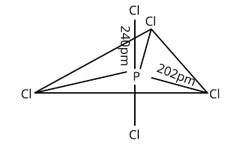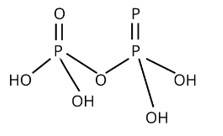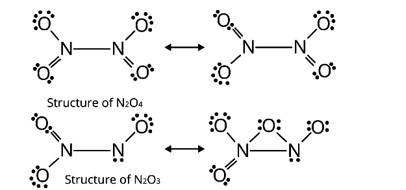P Block Elements
Get insights from 254 questions on P Block Elements, answered by students, alumni, and experts. You may also ask and answer any question you like about P Block Elements
Follow Ask QuestionQuestions
Discussions
Active Users
Followers
New answer posted
3 months agoContributor-Level 10
This is a short answer type question as classified in NCERT Exemplar
NO2 exists as a monomer with one unpaired electron in the gaseous state, but it dimerises to N2O4 in the solid state, leaving no unpaired electron, making the solid form diamagnetic.
New answer posted
3 months agoContributor-Level 10
This is a short answer type question as classified in NCERT Exemplar
Three P—Cl bonds are arranged in one plane at a 1200 angle. These bonds are known as equatorial bonds because they are formed between two points. The remaining two P—Cl bonds, one above the equatorial plane and the other below it, form 90° angle with the plane. Axial bonds are the name for these types of bonds. Because axial bond pairs are subjected to greater repulsive interaction than equatorial bond pairs, axial bonds are slightly longer and hence slightly weaker than equatorial bonds, making the PCl5 molecule more reactive.

New answer posted
3 months agoContributor-Level 10
This is a short answer type question as classified in NCERT Exemplar
PH3 is insoluble in water and cannot create hydrogen bonds with it, it forms bubbles, whereas NH3 dissolves because it is soluble in water and can form hydrogen bonds with it.
New answer posted
3 months agoContributor-Level 10
This is a short answer type question as classified in NCERT Exemplar

New answer posted
3 months agoContributor-Level 10
This is a short answer type question as classified in NCERT Exemplar
4NH3 + 5O2 ![]() 4NO + 6H2O
4NO + 6H2O
New answer posted
3 months agoContributor-Level 10
This is a short answer type question as classified in NCERT Exemplar
SO3 generates a dense fog of sulphuric acid that does not condense quickly, it is not absorbed directly in water to form H2SO4.
New answer posted
3 months agoContributor-Level 10
This is a long answer type question as classified in NCERT Exemplar
A = NH4NO2
B = N2
C = NH3
D = HNO3
(i) NH4NO2→N2 + 2H2O
(ii) N2 + 3H2→2NH3
(iii) 4NH3 + 5O2→4NO + 6H2O
4NO + O2→4NO2
3NO2 + H2O→2HNO3 + NO
New answer posted
3 months agoContributor-Level 10
This is a long answer type question as classified in NCERT Exemplar
Here, 'A' is NO2 (Nitrogen dioxide)
'B' is N2O4 (dinitrogen tetraoxide)
'C' is N2O3 (dinitrogen trioxide)
A brown gas is produced when lead nitrate (II) is heated

2Pb (NO3)2 ![]() 2PbO + 4NO2 + O2
2PbO + 4NO2 + O2
2NO2 ![]() N2O4
N2O4
2NO + N2O4  2N2O3
2N2O3
New answer posted
3 months agoContributor-Level 10
This is a long answer type question as classified in NCERT Exemplar
'A' is S8 'B' is SO2 gas
S8 + 8O2 ![]() 8SO2
8SO2
2MnO4 – + 5SO2 + 2H2O → 5 SO42– + 4H+ + 2Mn2+
(violet) (colourless)
2Fe3+ + SO2 + 2H2O → 2Fe2+ + SO42– + 4H+
New answer posted
4 months agoContributor-Level 10
7.70
As Bond dissociation energy generally decreases on moving down the group as the atomic size of the element increases. However, among halogens, the bond dissociation energy of F2 is lower than that of Cl2 and F2 due to the small atomic size of
Thus increasing order for bond dissociation energy among halogens is as follows:I22
As Bond dissociation energy of H-X molecules where X is the halogen decreases with increase in the atomic HI is the strongest acid as it loses H atom easily due to weak bonding between H and I.
So Increasing acid strength is as follows: HF
Basic strength decreases as we move from Nitrogen to Bismuth down the group
Taking an Exam? Selecting a College?
Get authentic answers from experts, students and alumni that you won't find anywhere else
Sign Up on ShikshaOn Shiksha, get access to
- 65k Colleges
- 1.2k Exams
- 688k Reviews
- 1800k Answers
